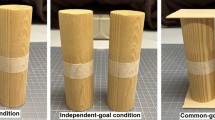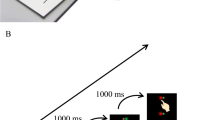Abstract
Nondisabled adults utilize both planning and feedback-based compensatory adjustments to control actual distance moved for skilled reach actions. The purpose of this study was to determine whether individuals post-stroke utilize planning and compensatory adjustments to control movement distance for reaches to targets that vary in distance. Individuals with mild to moderate motor impairment after stroke and nondisabled adults reached with both arms to targets presented at three distances (8, 16, 24 cm). The control of movement distance was compared between arms (control, nonparetic, and paretic) as to the use of planning (correlation of peak acceleration with movement distance), compensatory adjustments prior to peak velocity (correlation of time to peak velocity with movement distance), and compensatory adjustments after peak velocity (variance in movement distance accounted for by deterministic statistical model). The correlation of peak acceleration with movement distance for reaches with the paretic arm was significantly less than controls suggesting a decreased reliance on planning. Feedback-based compensatory adjustments, however, were present prior to and after peak velocity that assisted in achievement of movement distance in a similar manner as controls. Overall reach performance with the paretic arm was impaired, however, as evidenced by greater endpoint error and longer movement times than controls. The decreased use of planning to control movement distance after stroke suggests that the selected motor command was suboptimal in producing the desired movement outcome and may be related to an inability to generate muscle force quickly, lack of knowledge of arm dynamics due to decreased arm use, or lesion characteristics.






Similar content being viewed by others
References
Andersen RA, Cui H (2009) Intention, action planning, and decision making in parietal-frontal circuits. Neuron 63:568–583
Bamford J, Sandercock P, Dennis M, Burn J, Warlow C (1991) Classification and natural history of clinically identifiable subtypes of cerebral infarction. Lancet 337:1521–1526
Barker RN, Gill TJ, Brauer SG (2007) Factors contributing to upper limb recovery after stroke: a survey of stroke survivors in Queensland Australia. Disabil Rehabil 29:981–989
Brown SH, Cooke JD (1984) Initial agonist burst duration depends on movement amplitude. Exp Brain Res 55:523–527
Calarusso RP, Hammill DD (1972) The motor-free visual perception test (MVPT). Academic Therapy Publications, San Rafael
Canning CG, Ada L, O’Dwyer NJ (2000) Abnormal muscle activation characteristics associated with loss of dexterity after stroke. J Neurol Sci 176:45–56
Carey LM, Matyas TA (2011) Frequency of discriminative sensory loss in the hand after stroke in a rehabilitation setting. J Rehabil Med 43:257–263
Chae J, Yang G, Park BK, Labatia I (2002) Delay in initiation and termination of muscle contraction, motor impairment, and physical disability in upper limb hemiparesis. Muscle Nerve 25:568–575
Connell LA, Lincoln NB, Radford KA (2008) Somatosensory impairment after stroke: frequency of different deficits and their recovery. Clin Rehabil 22:758–767
DeJong SL, Birkenmeier RL, Lang CE (2012) Person-specific changes in motor performance accompany upper extremity functional gains after stroke. J Appl Biomech 28:304–316
Desmurget M, Grafton S (2000) Forward modeling allows feedback control for fast reaching movements. Trends Cogn Sci 4:423–431
Dukelow SP, Herter TM, Moore KD et al (2010) Quantitative assessment of limb position sense following stroke. Neurorehabil Neural Repair 24:178–187
Duncan PW, Wallace D, Lai SM, Johnson D, Embretson S, Laster LJ (1999) The stroke impact scale version 2.0. Evaluation of reliability, validity, and sensitivity to change. Stroke 30:2131–2140
Fisher BE, Winstein CJ, Velicki MR (2000) Deficits in compensatory trajectory adjustments after unilateral sensorimotor stroke. Exp Brain Res 132:328–344
Fogassi L, Luppino G (2005) Motor functions of the parietal lobe. Curr Opin Neurobiol 15:626–631
Folstein MF, Folstein SE, McHugh PR (1975) “Mini-mental state”. A practical method for grading the cognitive state of patients for the clinician. J Psychiatr Res 12:189–198
Fugl-Meyer AR, Jaasko L, Leyman I, Olsson S, Steglind S (1975) The post-stroke hemiplegic patient. 1. a method for evaluation of physical performance. Scand J Rehabil Med 7:13–31
Ghez C, Gordon J (1987) Trajectory control in targeted force impulses. I. Role of opposing muscles. Exp Brain Res 67:225–240
Gordon J, Ghez C (1987a) Trajectory control in targeted force impulses. II Pulse height control. Exp Brain Res 67:241–252
Gordon J, Ghez C (1987b) Trajectory control in targeted force impulses. III. Compensatory adjustments for initial errors. Exp Brain Res 67:253–269
Harris JE, Eng JJ (2006) Individuals with the dominant hand affected following stroke demonstrate less impairment than those with the nondominant hand affected. Neurorehabil Neural Repair 20:380–389
Hartman-Maeir A, Katz N (1995) Validity of the behavioral inattention test (BIT): relationships with functional tasks. Am J Occup Ther 49:507–516
Hoshi E, Tanji J (2007) Distinctions between dorsal and ventral premotor areas: anatomical connectivity and functional properties. Curr Opin Neurobiol 17:234–242
Kawato M (1999) Internal models for motor control and trajectory planning. Curr Opin Neurobiol 9:718–727
Kitago T, Liang J, Huang VS et al (2013) Improvement after constraint-induced movement therapy: recovery of normal motor control or task-specific compensation? Neurorehabil Neural Repair 27:99–109
Kokotilo KJ, Eng JJ, McKeown MJ, Boyd LA (2010) Greater activation of secondary motor areas is related to less arm use after stroke. Neurorehabil Neural Repair 24:78–87
Lang CE, Wagner JM, Bastian AJ, Hu Q, Edwards DF, Sahrmann SA, Dromerick AW (2005) Deficits in grasp versus reach during acute hemiparesis. Exp Brain Res 166:126–136
Levin MF (1996) Interjoint coordination during pointing movements is disrupted in spastic hemiparesis. Brain 119(Pt 1):281–293
Levin MF, Michaelsen SM, Cirstea CM, Roby-Brami A (2002) Use of the trunk for reaching targets placed within and beyond the reach in adult hemiparesis. Exp Brain Res 143:171–180
Longo MR, Azanon E, Haggard P (2010) More than skin deep: body representation beyond primary somatosensory cortex. Neuropsychologia 48:655–668
Lyle RC (1981) A performance test for assessment of upper limb function in physical rehabilitation treatment and research. Int J Rehabil Res 4:483–492
Mani S, Mutha PK, Przybyla A, Haaland KY, Good DC, Sainburg RL (2013) Contralesional motor deficits after unilateral stroke reflect hemisphere-specific control mechanisms. Brain 136:1288–1303
McCombe Waller S, Whitall J (2005) Hand dominance and side of stroke affect rehabilitation in chronic stroke. Clin Rehabil 19:544–551
McCrea PH, Eng JJ (2005) Consequences of increased neuromotor noise for reaching movements in persons with stroke. Exp Brain Res 162:70–77
Messier J, Kalaska JF (1999) Comparison of variability of initial kinematics and endpoints of reaching movements. Exp Brain Res 125:139–152
Mutha PK, Sainburg RL (2007) Control of velocity and position in single joint movements. Hum Mov Sci 26:808–823
Oldfield RC (1971) The assessment and analysis of handedness: the Edinburgh inventory. Neuropsychologia 9:97–113
Platz T, Prass K, Denzler P, Bock S, Mauritz KH (1999) Testing a motor performance series and a kinematic motion analysis as measures of performance in high-functioning stroke patients: reliability, validity, and responsiveness to therapeutic intervention. Arch Phys Med Rehabil 80:270–277
Platz T, Bock S, Prass K (2001) Reduced skilfulness of arm motor behaviour among motor stroke patients with good clinical recovery: does it indicate reduced automaticity? Can it be improved by unilateral or bilateral training? A kinematic motion analysis study. Neuropsychologia 39:687–698
Portney L, Watkins M (2009) Foundations of Clinical Research: applications to practice. Prentice-Hall, Upper Saddle River
Romo R, Lemus L, de Lafuente V (2012) Sense, memory, and decision-making in the somatosensory cortical network. Curr Opin Neurobiol 22:914–919
Sabes PN (2000) The planning and control of reaching movements. Curr Opin Neurobiol 10:740–746
Sainburg RL, Schaefer SY (2004) Interlimb differences in control of movement extent. J Neurophysiol 92:1374–1383
Schaefer SY, Haaland KY, Sainburg RL (2007) Ipsilesional motor deficits following stroke reflect hemispheric specializations for movement control. Brain 130:2146–2158
Semrau JA, Herter TM, Scott SH, Dukelow SP (2013) Robotic identification of kinesthetic deficits after stroke. Stroke 44:3414–3421
Stewart JC, Cramer SC (2013) Patient-reported measures provide unique insights into motor function after stroke. Stroke 44:1111–1116
Stewart JC, Gordon J, Winstein CJ (2013) Planning and adjustments for the control of reach extent in a virtual environment. J Neuroeng Rehabil 10:27
Stewart JC, Gordon J, Winstein CJ (2014) Control of reach extent with the paretic and nonparetic arms after unilateral sensorimotor stroke: kinematic differences based on side of brain damage. Exp Brain Res 232:2407–2419
Tunik E, Rice NJ, Hamilton A, Grafton ST (2007) Beyond grasping: representation of action in human anterior intraparietal sulcus. Neuroimage 36(Suppl 2):T77–T86
van Kordelaar J, van Wegen EE, Nijland RH, de Groot JH, Meskers CG, Harlaar J, Kwakkel G (2012) Assessing longitudinal change in coordination of the paretic upper limb using on-site 3-dimensional kinematic measurements. Phys Ther 92:142–151
Wagner JM, Dromerick AW, Sahrmann SA, Lang CE (2007a) Upper extremity muscle activation during recovery of reaching in subjects with post-stroke hemiparesis. Clin Neurophysiol 118:164–176
Wagner JM, Lang CE, Sahrmann SA, Edwards DF, Dromerick AW (2007b) Sensorimotor impairments and reaching performance in subjects with poststroke hemiparesis during the first few months of recovery. Phys Ther 87:751–765
Williams PS, Basso DM, Case-Smith J, Nichols-Larsen DS (2006) Development of the hand active sensation test: reliability and validity. Arch Phys Med Rehabil 87:1471–1477
Winter D (2005) Biomechanics and motor control of human movement. John Wiley & Sons Inc, Hoboken
Wolf SL, Winstein CJ, Miller JP et al (2006) Effect of constraint-induced movement therapy on upper extremity function 3 to 9 months after stroke: the EXCITE randomized clinical trial. JAMA 296:2095–2104
Wolpert DM, Ghahramani Z (2000) Computational principles of movement neuroscience. Nat Neurosci 3(Suppl):1212–1217
Acknowledgments
The authors would like to thank Lee Johnson and Bruce Larson for assistance with modifications to the virtual reality system and Liang-Ching Tsai for figure development. The virtual reality system used in this study was provided by Innovative Sports Training, Inc. Funding for this research was provided in part through a Mary McMillan Doctoral Scholarship and a Promotion of Doctoral Studies II Scholarship from the Foundation for Physical Therapy and a grant from the California Physical Therapy Fund.
Author information
Authors and Affiliations
Corresponding author
Rights and permissions
About this article
Cite this article
Stewart, J.C., Gordon, J. & Winstein, C.J. Control of reach extent with the paretic and nonparetic arms after unilateral sensorimotor stroke II: planning and adjustments to control movement distance. Exp Brain Res 232, 3431–3443 (2014). https://doi.org/10.1007/s00221-014-4025-7
Received:
Accepted:
Published:
Issue Date:
DOI: https://doi.org/10.1007/s00221-014-4025-7




